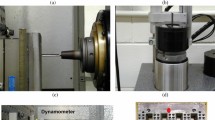Abstract
The machinability of stran-dcast free-machining steels newly developed jointly by Nippon Steel Corporation and Inland Steel Company is compared to that of ingot-cast steels. The effect on machinability of such metallurgical factors as the size and shape of manganese sulfide inclusions, lead particles, and oxides, that are likely to change as the shift is made from the ingot-casting process to the strandcasting process is discussed. The results of this study show that strand-cast products contain somewhat smaller manganese sulfides, but that, unlike ingot-cast products, they are free from the segregation of machinability-improving inclusions and hard oxides. Therefore, strand-cast steels are as machinable as the average ingotcast steels, are less variable in machinability and are more consistent in quality. It has also been found that machinability is improved as the amount of manganese sulfides, lead particles, and the size of manganese sulfides increase and as the amount of oxides decreases. However, it has been observed that the effect of manganese sulfide shape varies with the machining condition. This report also discusses the effect on improved machinability of the manganese sulfide deposit on the tool.
Similar content being viewed by others
References
B. Laszlo: “Influence of Metallurgy on Machinability of Steel,”Int. Symp., ISIJ and ASM, Tokyo (1977) p. 27.
K. Uesugi, M. Araki, V. Yamamato, T. Nishimura, S. Okano, K. Mine, Y. Shinjo, S. Omori, Y. Yada:Iron and Steel Japan, Vol. 68, No. 2 (1982), P. A85.
V. A. Tipnis, and R. A. Joseph:Trans, ASME, B. Vol. 93, No. 2 (1971), p. 559.
S. Katayama, T. Imai, and S. Suzuki: Tetsu-to-Hagane,Vol. 71 (1985), p. S530.
S. Izumi, Y. Koyasu, S. Ohtani, T. Ohsasa, Y. Tanefuji, K. Ishiyama, and K. Sugawara:Tetsu-to-Hagane. Vol. 69 (1983), P. S515.
F. W. Boulger, H. A. Moorhead, and T. M. Garvey:Iron Age, Vol. 167(1951), p. 90.
H. Van Vlack:Trans, ASM, Vol. 45 (1953), p. 741.
G. J. Marsten, and J. D. Murray:JISI, Vol. 208 (1970), p. 568.
G. B. Troup:Automatic Machining (January, 1966), p. 66.
S. Ramalingan, B. Thomann, K. Basu, J. Hazra: Int. Conf. “Influence of Metallurgy on Machinability,” ASM, (1975) p. 111.
R. A. Joseph, and V. A. Tipnis: Int. Conf. “Influence of Metallurgy on Machinability,” ASM, (1975), p. 55.
E. M. Trent:JISI, Vol. 201 (1963), p. 1001.
J. E. Williams and E. C. Rollason,J. Inst. Metals, Vol. 98 (1970), p. 144.
S. Katayama, T. Imai, Y. Koyasu, and S. Ohtani:Tetsu-to Hagane, Vol. 71 (1985), p. S532.
K. Narita, T. Fujita, Y. Yamaguchi, T. Makino, T. Kaneda, Y. Yamagi:Iron and Steel Japan, Vol. 58 (1972), p. S211.
Author information
Authors and Affiliations
Rights and permissions
About this article
Cite this article
Ohtani, S., Katayama, S., Akasawa, T. et al. Qualities of strand cast resulfurized free-machining steels. J. Applied Metalworking 4, 245–254 (1986). https://doi.org/10.1007/BF02833932
Issue Date:
DOI: https://doi.org/10.1007/BF02833932




